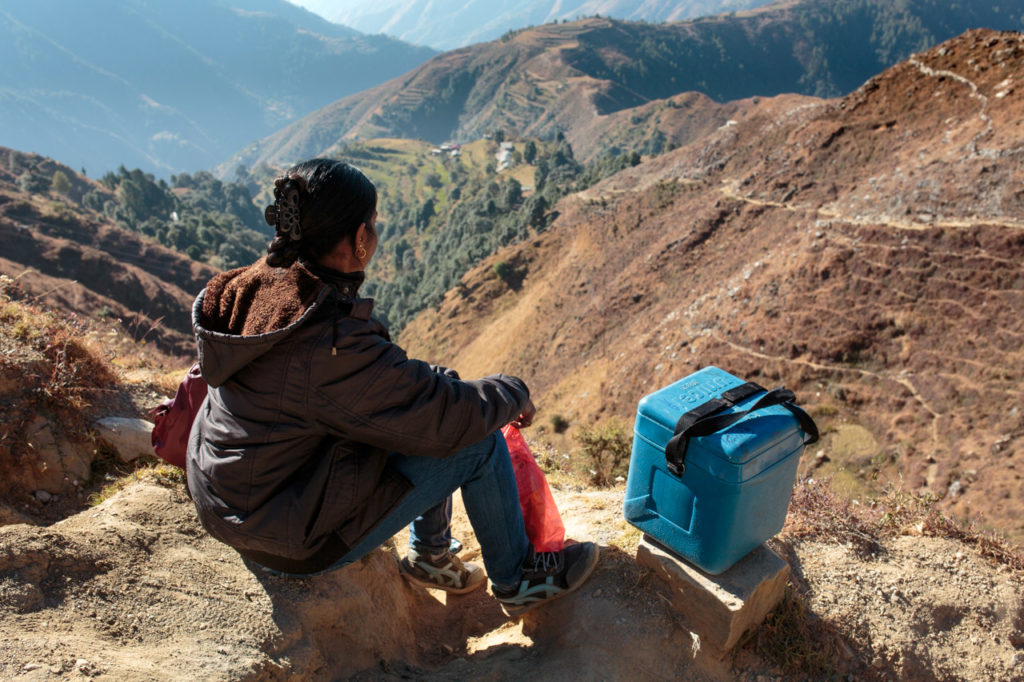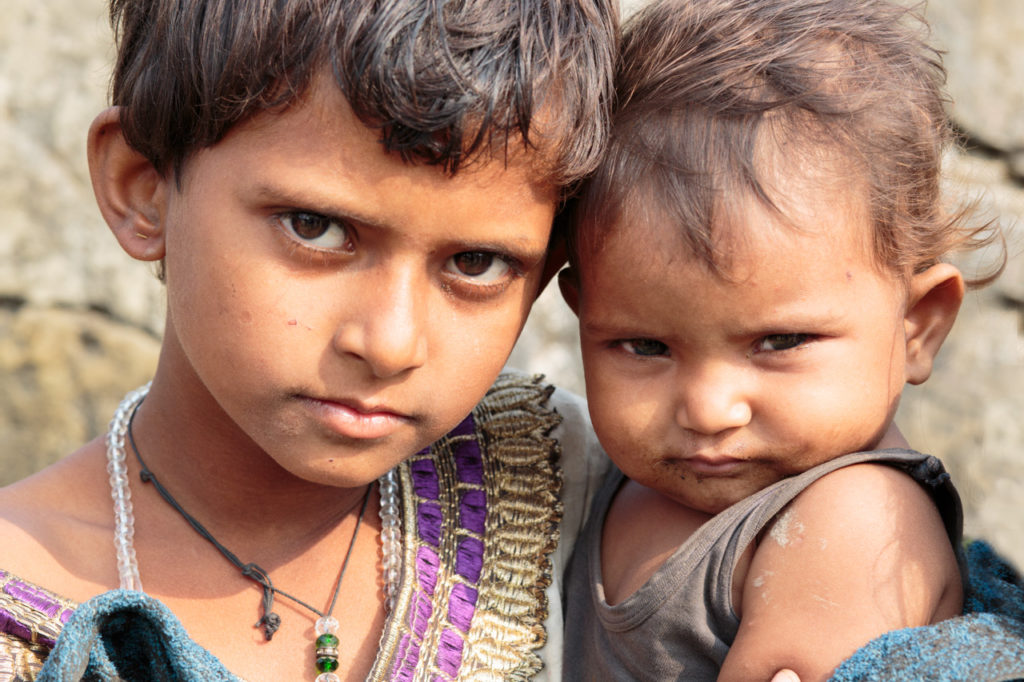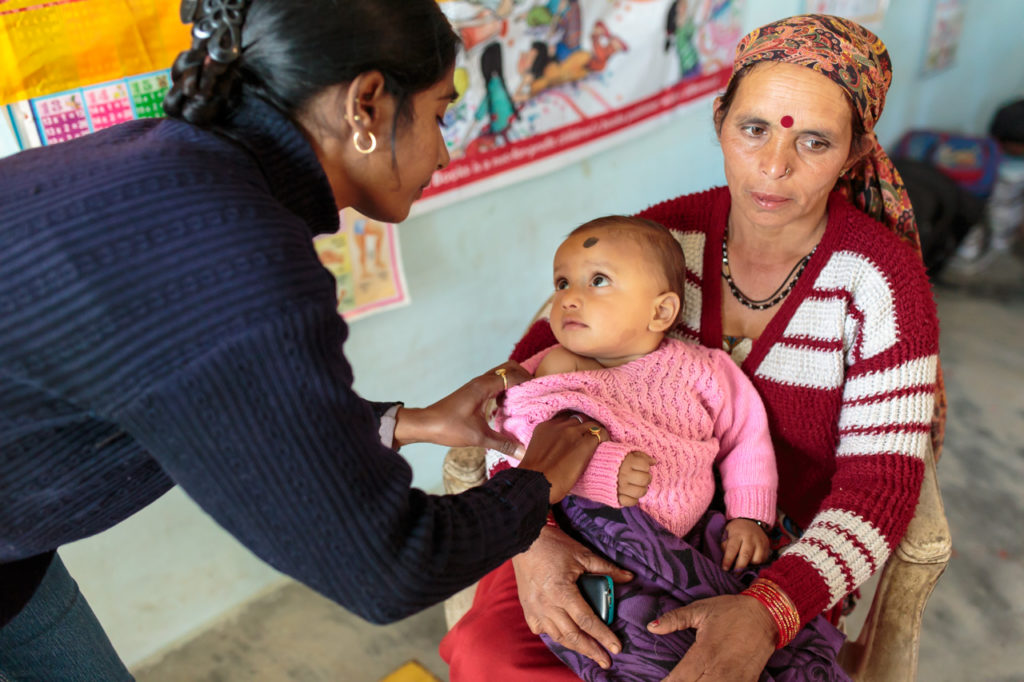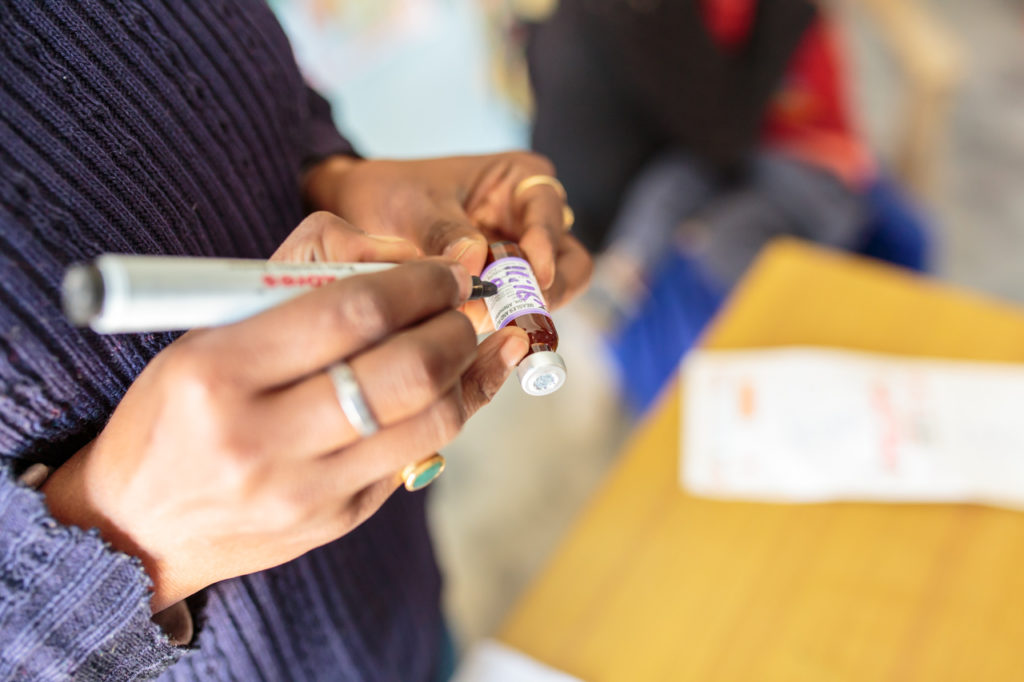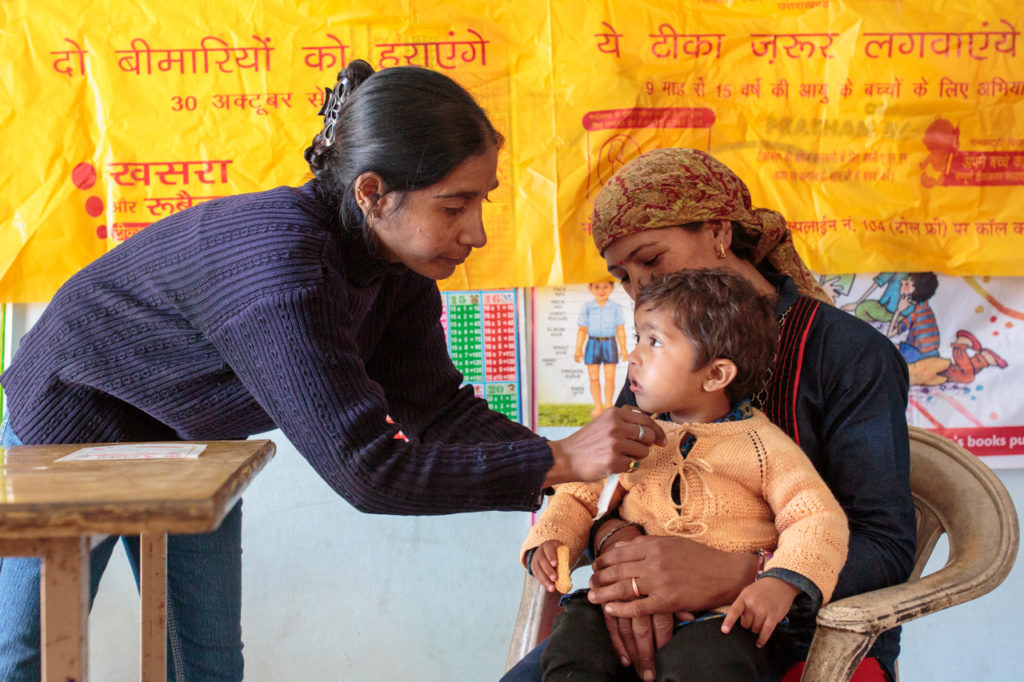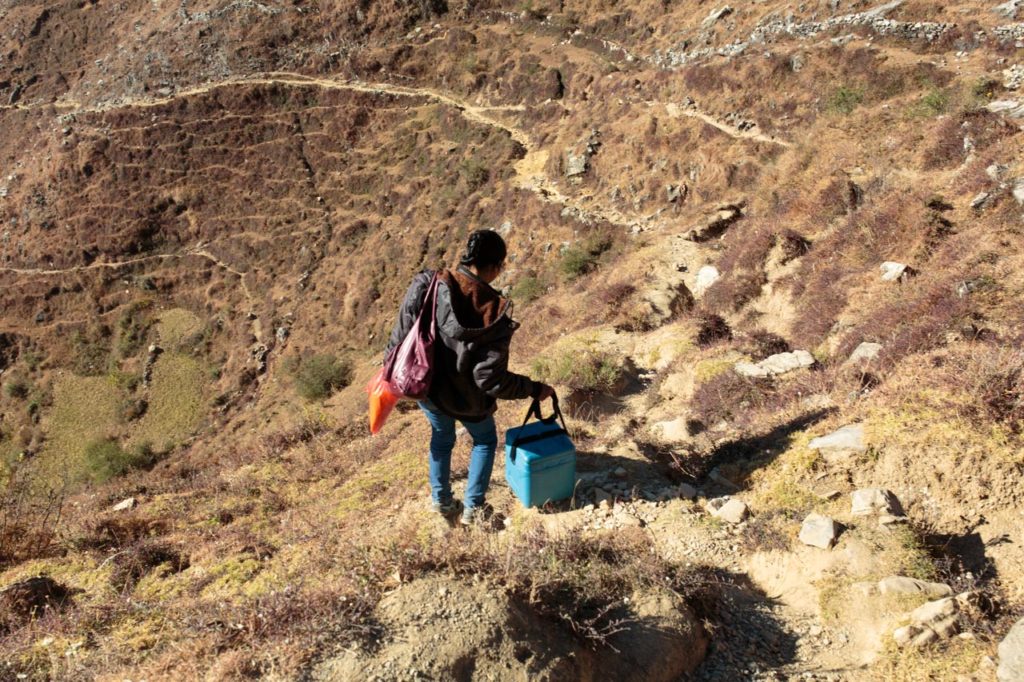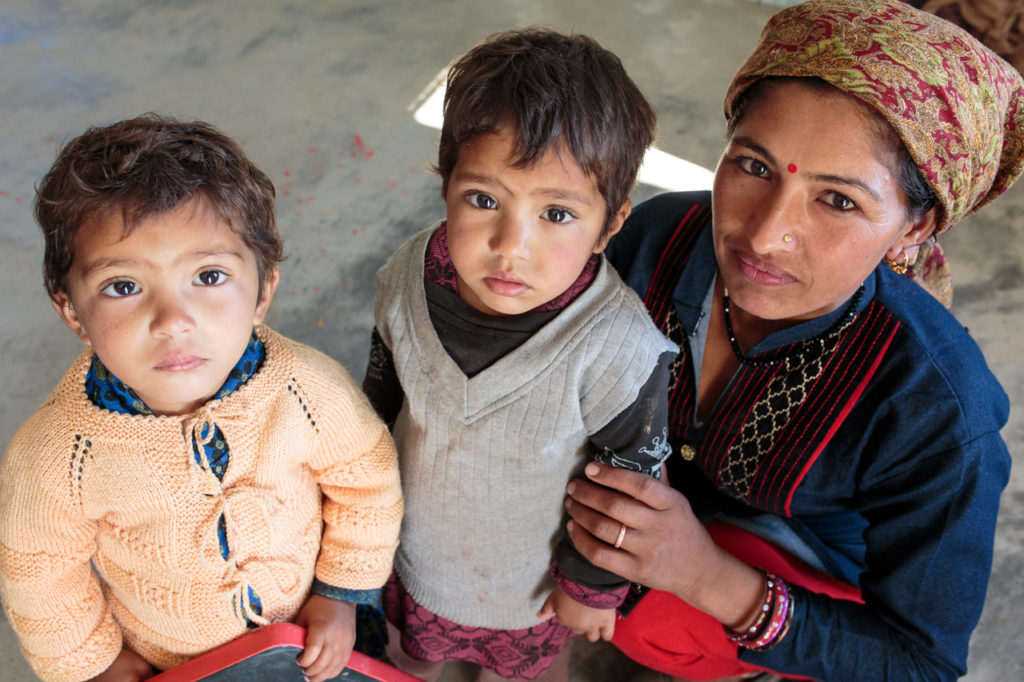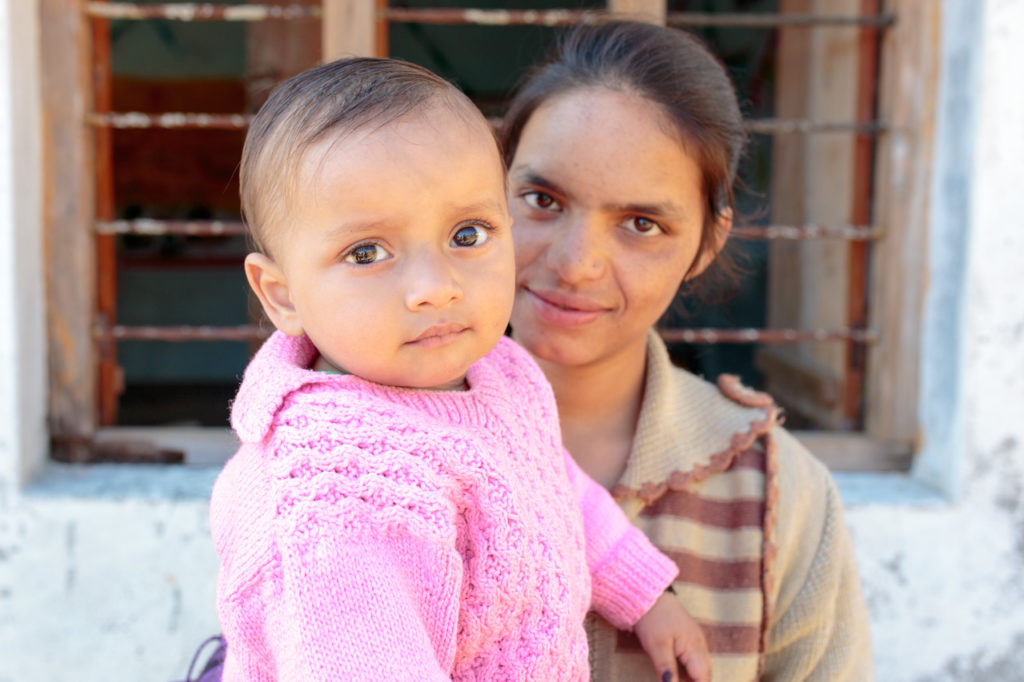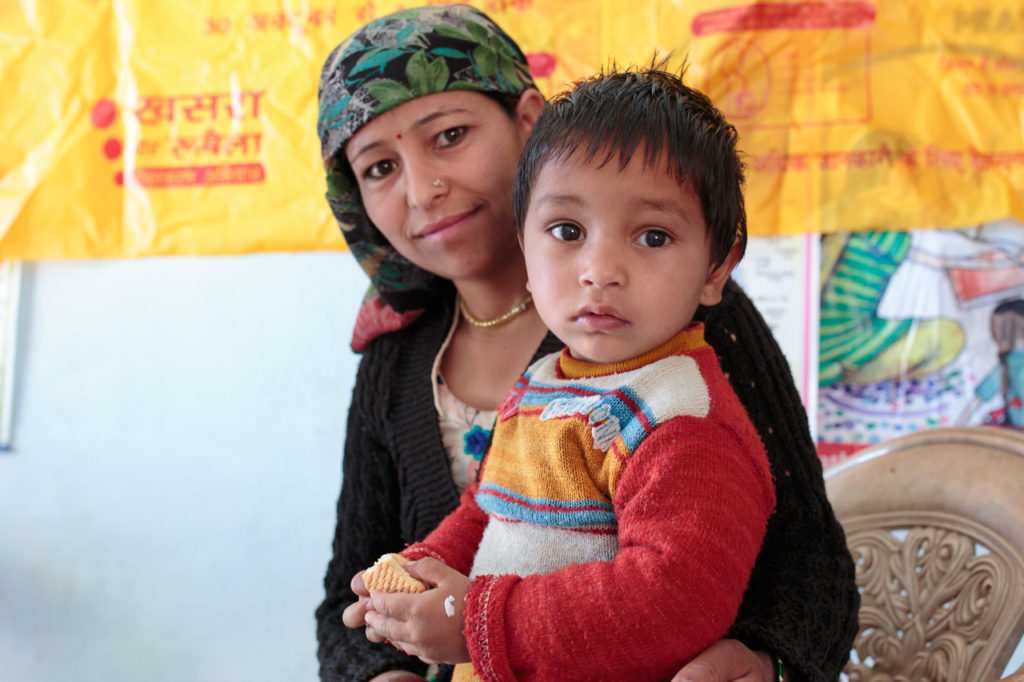
The children sit at their desks, their backpacks neatly arranged in front of them. They’re ready to learn: reading, writing, Hindi, English, maths, geography. There’s a map on the wall in this two-room school, posters with illustrations of types of food and the Hindi letters. A winter sun shines through the open windows, and the room echoes with sounds of the Dehradun hills – songbirds, farm equipment, a cow.
But it’s not an ordinary morning at Bhangar school, situated in a remote hilly district in India’s north-east. Today, there are visitors. Some are too young for school: twins, about two years of age, play together with toys as their parents watch over them. Baby Golu, about one, sits in her mother’s lap on the floor. There is little Gunjan, aged 4, wearing a woolen sweater striped in purples and pinks. She reaches out as she is handed a colorful card marked with her name and age.
There is Purnima Marthuria, the health worker, busy pinning a large banner to the wall. She arranges her station: an ice pack, a vial of vaccine, cotton swabs, packaged needles and syringes, a sharps safety box. To reach the school, Purnima and her colleagues walked for about one hour down a steep, dusty and sometimes treacherous path. The Dehradun hills rose around them, veiled in a December haze. “Walking down was challenging, but we managed,” says Purnima. “Walking up will be difficult.”
Today is measles-rubella campaign day at Bhangar school – the first ever. Purnima is aiming to vaccinate 12 kids. Her effort on this day to reach just a few children in Dehradun district in Uttarakhand state is part of one of the world’s largest health campaigns in history.
One of biggest health campaigns in the world
By the end of 2018, India aims to reach almost 410 million children aged 9 months to 15 years with measles-rubella vaccine. It’s a two-year campaign, phased across each Indian state and territory. The combined vaccine will protect children against measles – one of the most infectious viruses on earth. In a first for the country, children will also be protected against rubella – a contagious virus which can cause serious birth defects in utero. About 30% of global measles deaths occur in India, mainly of young children under five years of age, as do about 40% of cases of congenital rubella syndrome. The good news is that the measles-rubella vaccine is so effective that high coverage with just two doses can eliminate circulation of these viruses. “We’re aiming for 100% coverage,” explains Dr. Rakesh Vishwakarma, the World Health Organization (WHO) expert assisting the state of Uttarakhand with its measles-rubella campaign.
In order to succeed, every village, no matter how small, has been mapped. Looking out over the 7,000-foot hills, the challenge is obvious. There are villages – sometimes of just three or four homes – at the very top of hills, in the steep valleys below, and at every elevation in between. In Uttarakhand state alone, health workers must reach 2.8 million children. To achieve this, 60,000 workers have been trained to administer 27,000 vaccination sessions in just one month.
Government ownership, GAVI support, polio lessons
“Success involves everyone,” says Dr. Vishwakarma. “Health workers of course, but also every teacher in the state.”
“Government is really engaged,” he says. “They are the backbone of this campaign.” The Government of India is funding most of this measles-rubella campaign. GAVI, the Vaccine Alliance, which itself is funded by global donors, is covering 44% of the vaccine costs. Government of India ownership was also key to success of India’s polio eradication effort – a nationwide push that resulted in the last case of polio in India identified in January of 2011. Lessons from polio eradication are informing success of the enormous measles-rubella campaign. “The government is using the strategies of microplanning, training and monitoring that worked so well for polio eradication,” explains Dr. Vishwakarma. If the government reaches its target, measles and rubella could also one day be history in India.
Protecting children
In Bhangar school, each child is called up for their shot. Little Gunjan, in the purple and pink sweater, sits on her mother’s lap and hands over her immunization card. Purnima, the health worker, is quick with her work. She fills the syringe, and asks Gunjan to pull her sweater down to expose her shoulder. “Look the other way!” she tells her, as her mother covers Gunjan’s eyes. One second later, Gunjan has had her first shot of protection against measles and rubella.
This protection will help Gunjan grow up healthy, and go to school like the older girls around her. These school girls have big dreams – one would like to be an engineer; another, a teacher. When called, each child is quick to sit at Purnima’s vaccination station and receive their shot. Within thirty minutes, Purnima has vaccinated all of the children present. Little baby Golu, the toddler twins, Gunjan and the older school children hold up their immunization cards to show their vaccination status.
Purnima is especially pleased. “I came to Bhangar school to vaccinate 12 children,” she says. Because the entire village brought out their children, she surpassed the numbers in her plan. “Instead I reached 15 children,” she says. “I am so happy.” Purnima is just one of thousands of health workers walking to remote villages to vaccinate each Indian child aged nine months to 15 years against measles and rubella throughout 2018.
Despite the long walk back up the hill – and the fact she will do the same thing the next day, and the day after that – Purnima is optimistic. “If we keep doing the work diligently, it seems that we can eliminate these diseases from all of India.”
Eliminating measles and rubella globally
India’s current effort to stop measles and rubella is the largest in the world. Once the campaign ends, India will incorporate the measles-rubella vaccine into its routine immunization program. This is a critical contribution to the global goal to eliminate measles and rubella by the end of 2020. The Americas has already shown that eliminating the diseases is possible – an expert panel certified the end of endemic measles in 2002 and of rubella in 2015.
Today, the latest estimates show that just under 90,000 children died of measles in 2016 – the first time measles deaths have fallen below 100,000. The number is still far too large, but is a vast improvement over 2000, when the virus killed about 550,000 children. Measles notoriously has the biggest impact on children under five who are malnourished or whose immune systems are otherwise compromised.
As countries work to eliminate measles, many are introducing the combined measles-rubella vaccine to tackle two diseases at once. Congenital rubella syndrome (CRS) affects more than an estimated 100,000 births globally, and can cause stillbirths, heart disorders, blindness, deafness or brain damage. For parents in low-income countries, where children may not have access to corrective treatments, these conditions can be especially devastating.
Two doses of the combined vaccine costs just two US dollars, and protect children for life. This small investment will help health workers like Purnima to vaccinate children in remote villages, partners to help plan giant campaigns, and governments to protect every child.

